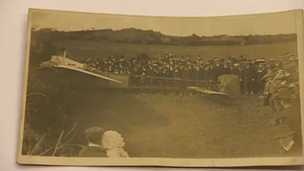Denys Corbett Wilson's 100 minutes of aviation in 1912
- Published
Against the backdrop of the Titanic disaster 100 years ago, a world in mourning began to look for new ways to cross the seas.
And just a week after "the unsinkable ship" hit an iceberg, a field in Pembrokeshire provided a glimmer of hope.
It was the launch site for the first flight from Britain to Ireland in an aeroplane which contemporary journalists called "the unthinkable".
Aged just 30, pilot Denys Corbett Wilson took off from Goodwick at 05:47 BST on 22 April 1912, and his Bleriot XI monoplane arrived at Enniscorthy, County Wexford exactly 100 minutes later.
This weekend the Pembrokeshire-based Corbett Wilson Centenary Celebration Society is marking the anniversary with a range of events including a vintage air show, a celebratory dinner with guest speaker, broadcaster and writer Trevor Fishlock, and a specially commissioned play at Fishguard's Theatr Gwaun.
100 Minutes tells the story of the Edwardian playboy who used his father's fortune as a barrister, to excel in his pursuits of horse-racing, motor-racing, and most significantly of all, aeroplane-racing.
"There was definitely a brash, egotistical and thrill-seeking side to Denys - he was very much the Jeremy Clarkson of his day," said Derek Webb, writer of '100 Minutes' which will be showing at Theatr Gwaun on Saturday.
'Fascination'
"But aside from the race horses, cars, speed boats and women, there was a deeper motivation.
"In common with so many rich young Edwardians, Denys had a fascination with new technologies, and a passion to push back the frontiers of human capability."
"There was also a strong sense that he wanted to make these achievements for Britain.

Corbett Wilson's plane was surrounded after it landed in Pembrokeshire
"You can see his patriotism in the way in which he signed up for the Royal Flying Corps, even though he wouldn't have been conscripted, as he was too old and had been injured in the Boer War."
The race to Ireland - against fellow aviation pioneer Damer Leslie Allen in an identical Bleriot XI - had started from Hendon Aerodrome on 17 April.
Allen, choosing a route to Dublin via Chester and Holyhead, took an early lead in the challenge, but crashed over the Irish Sea and his body was never discovered.
Meanwhile, Corbett Wilson opted to fly the southern route, over south Wales to Wexford, but suffered engine problems and had to put down in Herefordshire.
Choosing not to wait for his mechanic, who was following by train, Corbett Wilson lubricated his plane with castor oil from a chemist shop and refuelled with petrol siphoned from local agricultural machinery, and set off again immediately.
However he quickly realised that the mix of fuel wasn't right, and decided to land in Wales to wait for expert help before tackling the Irish Sea.
Goodwick became an entirely accidental footnote in the history of aviation.
Record
Had it not been for the weather, then Anglesey may have been the launch pad, as Welsh Aviator Vivian Hewitt had planned to fly the day before, but was grounded by thick fog.
He eventually made the crossing five days after Corbett Wilson, but shaved 10 minutes off the record, arriving in Dublin 90 minutes after take-off.
Corbett Wilson enjoyed much fame after the successful crossing, but on the outbreak of WWI two years later, he immediately volunteered for the newly-created Royal Flying Corps.
He and his navigator were killed in action on 10 May 1915, when their Morane Parasol aircraft was struck by German artillery.
His body is buried in the British War Cemetery at Cabaret-Rouge in France.